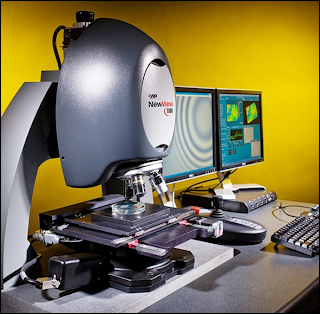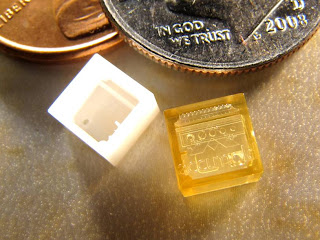"The world is your school." ~Martin H. Fischer 7/19/2012
My tasks at Accumold were incredibly varied. I worked with almost everyone in the company in one way or another—all shifts in small-mold and micro-mold production, quality, sales, management, inspection, tool room, and human resources. It was amazing to be able to see the company from a variety of angles, and it helped to be able to see some tasks played out full-circle. Some of my tasks included:
· Created a sample set of parts, varying in size and type of measurement tool/unit required to measure it.
· Individually tested the production employees on their measurement abilities with a caliper, a micrometer, and a tool scope (varying in inches and millimeters).
· Put together a training booklet for a production employee’s first day at Accumold.
· Assisted with online registration for their health insurance’s website to the employees who have chosen to use Accumold’s insurance provider.
· Put together a series of one-point lessons about health topics and suggestions.
· Created a one-point lesson on the value of deleting a negative amount in inventory.
· Recreated an MRB instruction sheet for electronically moving non-conforming parts.
· Recreated a sign-out log with instructions for MRB parts moving to/from the MRB table.
· Analyzed the ergonomics of a variety of positions and tasks.
· Developed a one-point lesson and follow-up questions for training employees on the medical standard ISO 13485:2003.
· Assisted employees, as needed, with their email, online pay stub, and online health insurance information.
Almost all of my tasks involved at least some technology and math. I was constantly crunching numbers, or talking to an employee about how their job involves a lot of numbers. It was interesting to me (but not surprising) how the need for computational math has substantially gone down. During a discussion with a man in the tool room, he brought up how there used to be so much trigonometry used to calculate the tiniest angles and measurements. Apparently there used to be a thick stack of papers filled with number crunching for each mold; now it’s all done fairly automatically with a computer program. For better or worse, times are changing, and that intense trig work just isn’t as necessary anymore. I found myself recognizing (again) the more important need for problem solving and critical thinking skills more than explicit math-specific skills. If I can get my kids to think, I’m doing my job. Now I’m not trying to down play the need for number sense and mathematical reasoning. I know they are important skills for life, but these general ways of thinking come along with the right approach to teaching more specific math skills.
Generally speaking, that’s my mentality for my classroom. When I get tossed the question, “When am I ever going to use this?” I can’t wait to be able to explain their need for thinking; they’re going to use problem solving all the time throughout life! J It’s not all about the math—and frankly, I believe that caring for family needs at night is more important than math homework (within reason)—however, I do hope to get the students thinking outside of their comfort zone. If I don’t stretch their thinking or get them excited to be learners….well, let’s just not think about that.
I’ve mentioned plenty of times how my curriculum can’t be directly changed because of this experience, and I know that we’re always in a time crunch to get in the information mandated by the district and core. That being said, I know I’m going to find many circumstances where I can include a tid-bit of information about a real-life math application. In the past, I have been told that I do a great job incorporating problem solving into my teaching strategies. With this experience behind me, the level of thinking I require will increase, thus having a nice impact on the kids. Problem solving strategies mixed in with a few actual real-world applications (aside from the standard stories involving a lemonade stand, trains traveling towards/away from each other, or a group of people painting a house).
One thing I wasn’t expecting to get from this externship was the overwhelming feeling of community. I never imagined a few short weeks would be enough time for the company to embrace my abilities and make me feel like a million bucks. I could always count on a familiar smiling face in the halls, offices, production floor, tool room, and break room. The friendly atmosphere and constant affirmations remind me how important that is for my students. I’ve always thought that I’ve done a decent job at praising my students’ accomplishments and successes, but oh boy they better watch out this next year—I’m fully loaded with a whole new tool box of ideas and a great motivation to use them! J
Here are a few other random things I’ve learned, witnessed, and will be taking away from this summer externship experience:
--“Selective Attention Test”. YouTube it, it’s worth it. (To make sure you have the right one, it has a couple kids tossing around a basketball)
--Slow down to go faster. Taking a step back to think, ask, and collaborate can save a lot of time in the long run.
--Teamwork and cooperation can make everyone’s job easier. Why not invest the time?
--Asking the question, “What sets you apart from your competition?” It provides an opportunity to show character (nice or cruel) while trying to prove a point.
--Spark by John Ratey. Book about the impact of exercise and how it can pretty much make everything in life better. The basis of his story begins with an explanation about a school in Naperville, Illinois that has implemented a new PE program for life fitness education.
--Eat That Frog by Brain Tracy. I haven’t read this one yet, but it claims to provide ideas on how and why not to procrastinate. Stems from idea that if you start everyday by eating a frog, you know that you’ve already done the worst (grossest) thing you’ll have to do that day. Get it done first, and it’s all better from there.
--5s strategy for organization, cleanliness, and standardization in a work space. “A place for everything, and everything in its place.”
--Process Mapping—an activity that explicitly describes every step in a process, including problems and decision points (sticky notes can be useful to move/brainstorm).
--The Invisible Gorilla by Christopher Chabris and Daniel Simons. This is another book I haven’t read yet, but it goes along with another part of this list. J “We think we see ourselves and the world as they really are, but we’re actually missing a whole lot.”
"A man who carries a cat by the tail learns something he can learn no other way." ~Mark Twain.
There's no way I could have learned about my experience this summer without simply experiencing it. I'm very thankful for my time here at Accumold, along with everything I'll be taking away. Now, that quote might imply a negative connotation, and that is not my intention as I have thoroughly enjoyed this externship! Also, it makes me think of my roommate's cat, and how that would be QUITE the experience. :)



